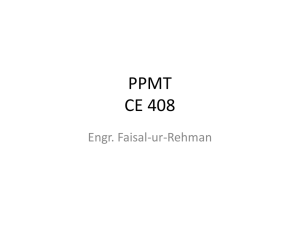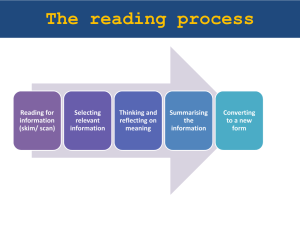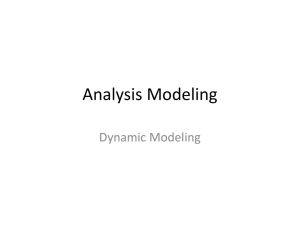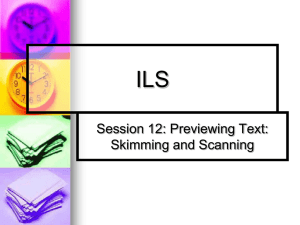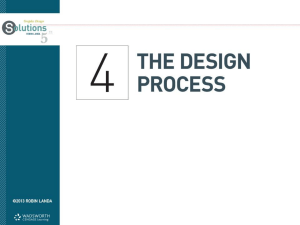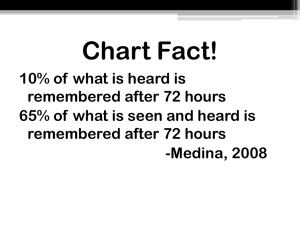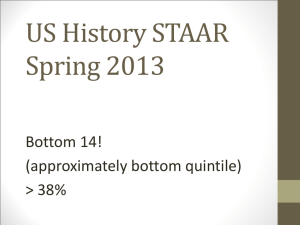Reading scientific & technical texts
advertisement
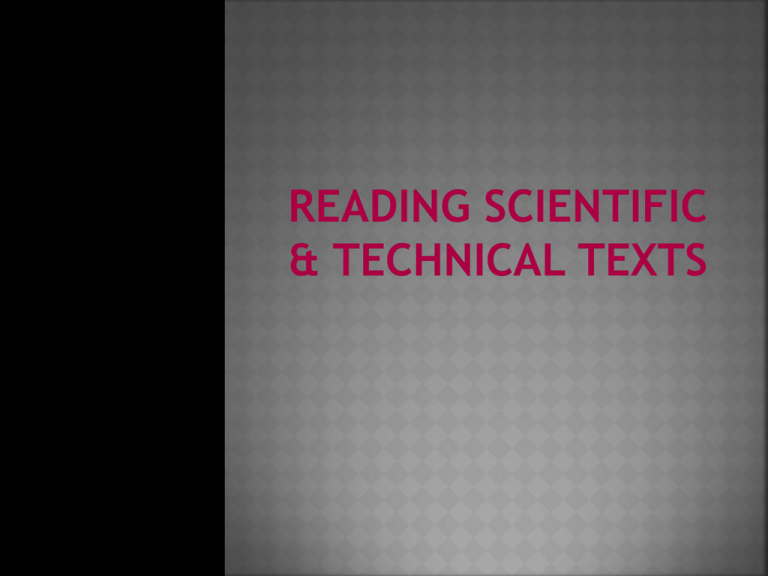
Reading scientific & technical texts involves Complex process of obtaining discipline-specific information & retaining this information for future use & reference Entails basic understanding of the subject & familiarity with the material Should be concerned with subject-content and the specific language used 1.Prepare for reading Focus and concentrate Use appropriate prediction techniques Recall related information Determine the time needed to complete the assignment 2. scan the text To get some key information to make reading faster and effective To discover graphic information Look for bibliography listings/notes/questions/remarks Identify non-verbal signs and aids 3. Skim the test to get better understanding To ensure high degree of remembrance To understand the gist To discover the purpose &organisation To understand the subject to know about author’s central idea To identify main points Need detailed and thorough reading observe the structure of text Analyse graphic information Respond to lexical meaning & functions of words Understand specific details recognize sentence patterns Recognize logical &thematic coherence Think critically & analytically Read silently Establish relationship between words and meanings Recognize discourse/semantic markers Needs careful reading plan Use note-making techniques Topicalise[central idea/main points/supporting points] [Eg. Petroleum is important from an economic stand point Topicalised : Economic importance of petroleum] Copying the exact words Transcribing what is said in the form of writing Schematize [using graphs to organise notes] Scientific information in the form of figures/classification/contrast Description of a substance- table Description of a process flow chart Narrative Description- Table Classificatory information- tree diagram Comparative Description – table, list Contrastive Description- table. list Figurative information-table, list The two best reading methods that can be used effectively for reading scientific and technical texts are: ERRQ Reading Technique The ERRQ technique was developed by Dorothy Watson in 1985. The basic purpose of this strategy is to get the reader to link with new information. Estimate Read Respond Question (what the text would be like) SQ3R Reading Technique SQ3R is a well-tried and widely accepted reading technique. This technique was developed by F.P. Robinson in 1946 in his book Effective Study. Survey ( discover purpose, organisation of text) Question( appropriate questions) Read Recall Revise (to check the accuracy of reading recall and review notes) Laboratory, workshop, gadgets, machines, project work etc. It requires the following effective reading strategies 1. Glance rapidly through the set of instructions to identify the nature & purpose of the instructions 2. Scan the graphic information 3. Recognize distribution of emphasis & focus points 4. Skim the instructions To skim the instructions Identify sequence of words to understand the coherence & logical structure of instructions Identify Number of steps/tasks involved Identify Main instructions Recognize transition points in the instructions Understand the ordering of instructions 5. skim& scan Read carefully after skimming &scanning 6. Note the following : Concentrate on precautions Understand the safety points Various kinds of technical manuals – guidelines to use operate, and maintain complex system Egs. Instruction manual/safety manuals regulations/user manuals Need various reading strategies Skimming, scanning, intensive reading, critical &inferential comprehension 1. 2. 3. 4. 5. 6. 7. Glance rapidly through the manual to get focus on subject, guess information of the text, aware of the aids in the text that make reading faster Skim before detailed reading to identify the nature & purpose of the manual Scan the graphic information, picture etc Read thoroughly to get all details Concentrate on safety part Identify precautions to be taken Consult glossary to know the meanings of unfamiliar words and scientific/technical terms Look for contextual signal words as well as examples that define indirectly an unknown word or phrase At the end recall and remember A technical writer uses many graphic techniques to present technical information. One should be able to read and interpret these graphic information There are generally four graphic aids used in technical documents: 1. Tables 2. Diagrams 3. Charts 4. graphs 1. 2. 3. 4. 5. 6. 7. Graphic aids Tables Bar charts/diagrams Tree diagrams Graphs/line charts/line diagrams Flow diagrams Pie charts/diagrams Flow charts Functions Organise data into group to related information Show comparative &contrastive information Show classification of data Show trend of relationship between two dimensions Show steps of process Show infmn related to proportions or % Present complex processes Diagrams and charts are used to simplify complex information's
